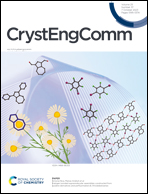Controllable design of a macroporous PBA as an efficient non-enzymatic electrochemical sensor for glucose detection†
Abstract
A novel highly sensitive and selective non-enzymatic electrochemical sensor of glucose has been achieved based on a macroporous bird's nest-like CoFePBA nanomaterial, namely HN-CoFePBA. Its pore size is about 750 nm. It is the first time that a hollow PBA material with such a big hole has been successfully obtained based on a two-step design strategy. Herein, ZIF-67 is selected as a sacrificial template and in situ converted and fabricated into the target PBA. More remarkably, the as-synthesized HN-CoFePBA as an electrochemical sensor realizes high-performance detection of glucose including a wide linear range of 5 μM–0.57 mM, a high sensitivity of 564.6 μA mM−1 cm−2, a low limit of detection (LOD), remarkable stability and good selectivity. The related sensing mechanism for the enhanced glucose performance is also discussed in detail. In a word, this work has developed a new avenue for the construction of macroporous PBA materials with excellent sensing performance.



 Please wait while we load your content...
Please wait while we load your content...